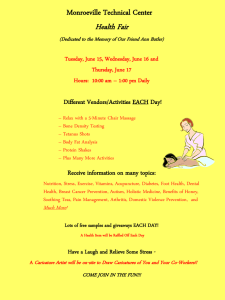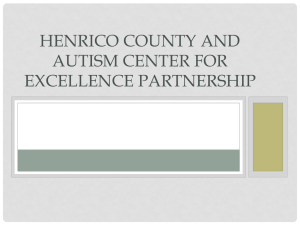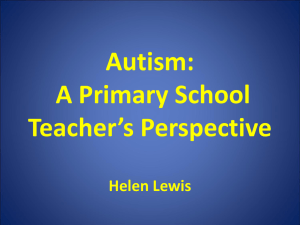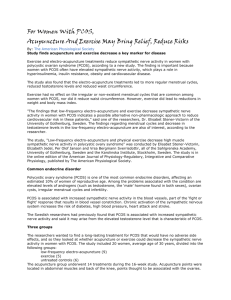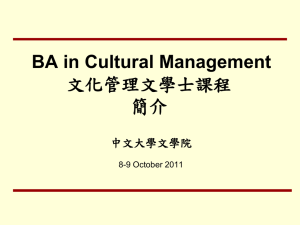2011.12.14
advertisement
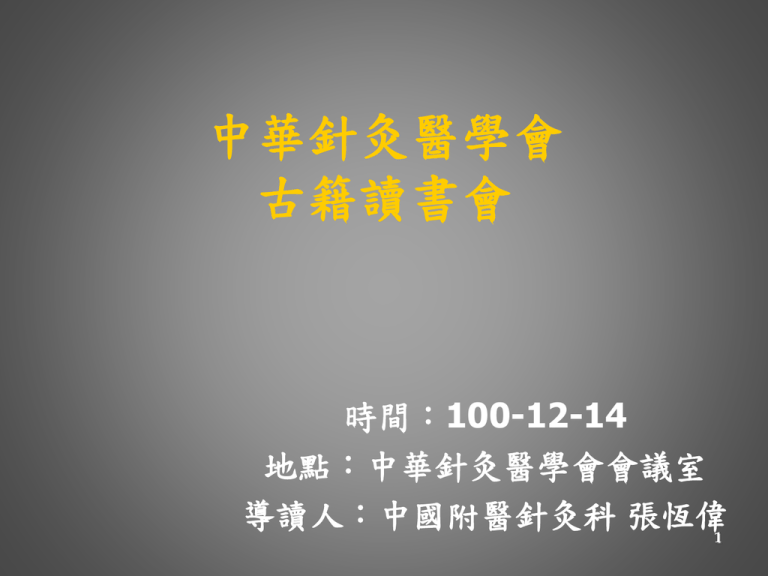
中華針灸醫學會 古籍讀書會 時間:100-12-14 地點:中華針灸醫學會會議室 導讀人:中國附醫針灸科 張恆偉1 難經第五十難 病邪有虛實賊微正 病有虛邪,有實邪,有賊邪,有微邪,有正邪, 何以別之?然:從後來者為虛邪,從前來者為 實邪,從所不勝來者為賊邪,從所勝來者為微 邪,自病者為正邪。何以言之?假令心病,中 風得之為虛邪,傷暑得之為正邪,飲食勞倦得 之為實邪,傷寒得之為微邪,中濕得之為賊 邪。。 2 難經第五十一難 病欲不同 病有欲得溫者,有欲得寒者,有欲得見人者, 有不欲得見人者,而各不同,病在何藏府也? 然:病欲得寒,而欲見人者,病在府也;病欲 得溫,而不欲見人者,病在藏也。何以言之? 府者,陽也,陽病欲得寒,又欲見人;藏者陰 也,陰病欲得溫,又欲閉戶獨處,惡聞人聲, 故以別知藏府之病也。。 3 《靈樞‧經脈》 胃足陽明之脈…是動則病洒洒振 寒,善呻數欠,顏黑,病至則惡人 與火,聞木聲則惕然而驚,心欲 動,獨閉戶塞牖而處,甚則欲上高 而歌,棄衣而走,賁響腹脹,是為 骭厥。 4 自閉症 美國的卡奈博士於一九四○年提出「嬰兒退縮 到自己的幻想世界裏, 無法與他人建立人際關 係。」稱之為「自閉症」。自閉症的發病年齡 在三十個月大以前,且大多在嬰幼兒時期即已 出現早期的特殊症狀。 5 自閉症 自閉症是一種先天腦部功能受損傷而引起的發 展障礙,通常在幼兒二 歲半以前就可以被發 現。自閉症患者從小開始便表現出語言理解和 表 達的困難、難與身旁的人建立情感、對各種 感官刺激的異常反應及一 成不變難以更改的固 定玩法與行為等和一般兒童不同的特徵。自閉 症 的特徵會隨著年齡、智商及自閉症的嚴重程 度而不同。 6 自閉症行為特徵 語言和溝通的障礙: 他們可能是沒有語言或遲滯,特殊的語言用法, 例如重覆問話者的部 分或全部問話內容;背誦 出曾聽過的廣告詞、話、歌曲等;「你」、 「我」、「他」分不清楚。即使隨著年齡增長 語言溝通有些進步,其 對話也呈現機械式地將 所背的回答出來。自閉症相對於其他能力有較 佳的記憶性,但理解、抽象、推理能力有缺陷。 7 自閉症行為特徵 人際互動的障礙: 無法與他人建立人際關係,某些自閉症在襁褓 時即被發現玩自己的手 腳、發呆、對人沒反應 也不喜歡人抱。眼晴不看人,甚至躲避視線的 接觸,不理人,視而不見,聽而不聞,不怕生 人,沒有明顯分離焦慮 ,即使遇到挫折也不會 主動尋求慰藉,外出時,自己走自己的,甚至 不會回頭找父母,不和別人一起玩,頂多只是 跑跑跳跳而己。 8 自閉症行為特徵 玩耍與活動的特徵: 出現重覆性行為或有固定特殊的玩法,無法玩 有規則的遊戲。另外也 會出現咬,舔,撕,丟, 聞東西,或是觸摸某些物品,斜眼看物,凝 視 反光,霓紅燈或旋轉物。除玩法固定外,也會 有固定化、儀式化的現象。 9 Randomized controlled trial of electro-acupuncture for autism spectrum disorder • Virginia C. N. Wong, FRCP(London, Glasgow), FRCPCH(UK)Division of Child Neurology/Developmental Padiatrics/Neurohabilitation; Department of Padiatrics and Adolescent Medicine, Queen Mary Hospital, The University of Hong Kong, Hong Kong, China ; • Wen-Xiong Chen, MD,PhD- Division of Child Neurology/Developmental Padiatrics/Neurohabilitation; Department of Padiatrics and Adolescent Medicine, Queen Mary Hospital, The University of Hong Kong, Hong Kong, China ; • Wu-Li Liu,BTCM-Tung Wah Hospital, The University of Hong Kong, Clinical Center for Teaching and Research in Chinese Medicine • Alternative Medicine Review 2010; 15(2):136-146 10 • Impact Factor: 3.571 Introduction • Autism spectrum disorder (ASD) is a neurodevelopmental disorder characterized by the triad of impairment of social interaction, communication, and stereotypic behavior. • About 40 percent of ASD children have used CAM, with acupuncture being the most common modality. • 自閉症(ASD)是一種 神經發展疾病,缺乏 社會互動、溝通及刻 板動作是此疾病的三 項要素。 • 將近四成的自閉症患 童曾接受過互補和替 代療法(CAM)的治 療,針灸是最普遍的 物理療法。 11 Objective • To date, no randomized, • 到目前為止,沒有隨機分 配且有控制組的試驗研究 controlled trial has 過電針治療自閉症的有效 studied the efficacy and 性和安全性。 safety of electroacupuncture in ASD. • This is the first double- • 這是研究電針治療自閉症 blind, randomized, 患兒的第一個雙盲、隨機 controlled trial (RCT) of 分配且有控制組的試驗, electro-acupuncture for 且其取穴基礎建立在先前 children with ASD and 相關試驗的取穴上。 is based on the selected acupoints from a previous pilot study. 12 Study Design • A double-blind, randomized, controlled trial was conducted from May 2005 to June 2006 at the Hong Kong West Cluster (Queen Mary Hospital, Duchess of Kent Children's Hospital, and Tung Wah Group of Hospitals [TWGH]). • 這個雙盲、隨機分配且 有控制組的試驗,在 2005年五月至2006年 六月於香港西聯網的多 所醫院進行。 13 Subjects and Methods • Patients • Randomization and Concealment Allocation • Intervention – Electro-acupuncture (EA) Group – Sham Electro-acupuncture (SEA) Group • Outcome Measures – Blinded Parental Assessment – Blinded Assessor Assessment • Statistical Analysis • 患童的納入 • 隨機且不公開的分組 • 介入 – 電針組 – 假電針組 • 結果評估 – 雙親的評估量表 – 協助者的評估量表 • 統計分析 14 Intervention • 患童每隔日接受一周三 • Children received three 次,為期四周的電針療 sessions of electro程。 acupuncture weekly on alternate days for four weeks. • 針灸使用消毒過、可拋 • Sterile disposable 0.3 x 4 棄式0.3 x 4 cm的針灸針 cm acupuncture needles (made in China-HWA-TO) • 未使用鎮靜劑,在針灸 were used. 療程中,雙親或主要照 • No sedation was used, and 顧者被鼓勵陪伴在患童 parents or caretakers were 身邊。 encouraged to stay with the child throughout the acupuncture course. 15 Electro-acupuncture (EA) Group1 • Eight acupoints were selected: – – – – – – – – Sishencong (EX-HN1) Yintang (EX-NH3) Neiguan (PC6) Shenmen (HT7) TaiChong (LR3) Ear naodian (AT3) Ear shenmen (TF4) Sanyinjiao (SP6) • 選用8個針灸穴位: – – – – – – – – 四神聰 印堂 內關 神門 太衝 耳腦點 耳神門 三陰交 16 耳腦點/枕(Ear naodian, AT3) • 經絡名稱:對耳屏區8穴 • 穴道別名:遺尿點/對耳屏3區 • 穴道類別與特色: – 屬性:屬於神經系統穴位 – 止暈作用 – 鎮靜作用 – 鎮驚作用:枕穴用於治療癲 癇、面肌抽搐 – 明目作用 • 資料來源:台灣數位典藏與數位學習國家型科 技計畫/當代中醫針灸之數位典藏計畫 http://tung.tsu.edu.tw/acupuncture/point _list_Ear93GB.aspx 17 Electro-acupuncture (EA) Group2 • 針灸治療進行時患童採仰 • The treatment took place 臥或坐姿。 with the child in either a supine or sitting position. • A portable electro• 可攜式的電針機連接上針 acupuncture machine 柄處,以疏密波的形式提 (Model HWATO SDZ-II, 供電刺激30分鐘。 Electronic Acupuncture Treatment Instrument, Suzhou Medical Appliance Factory, China) was connected to the handles of the acupuncture needles to provide electrical stimulation for 30 minutes. Spacing-density wave stimulation was applied. 18 Electro-acupuncture (EA) Group3 • In both groups the conventional interventional or educational program for ASD was continued. • Two cases from the EA group were maintained on neuroleptic drugs at the same dose during the study. • 在電針和假電針組中, 針對自閉症的慣例性介 入或教育課程無須中 斷。 • 電針組中兩位患童維持 服用與平時相同劑量的 神經安定藥。 19 Blinded Parental Assessment1 • The following outcome measures were provided by parents – ABC:A behavior rating scale for the assessment of treatment effects – consisting of five subscales • Irritability • Lethargy • stereotypy • hyperactivity • inappropriate speech – used at baseline and posttreatment • 以下的結果評量由雙親提 供 – 異常行為量表:是一種行為 的分級評定,用以評估療效 – 此量表包含5個次量表 • 躁動 • 昏睡 • 刻板動作 • 過動 • 不恰當的語言 – 在治療前和治療後都施測 20 Blinded Parental Assessment2 – RFRLS: A scale for rating – 利•弗菲文真實生活測量 symptoms of patients with 表:是一種針對自閉症患者 autism in real life settings 真實生活中的症狀分級評定 – consisting of five subscales – 包括5個次量表 • sensory motor • 感覺動作 • social relationships to • 人際關係 people • 情感反應 • affectual response • 感覺反應 • sensory response • 語言 • Language – 在治療前後皆施測 – used at baseline and posttreatment. 21 Blinded Parental Assessment3 – PEDI: A measure of functional ability in children, taking into account the use of special equipment and amount of caregiver assistance. – It consists of 197 functional skill items, 20 caregiver assistance activities, and 20 environmental modifications – used at baseline and posttreatment. – 兒童日常功能量表:是一 種測量兒童日常生活能力 的量表,包括使用特別工 具的能力和照顧者給予協 助的多寡 – 此量表包含197項功能技 巧項目、20項照顧者協助 的活動及20項環境適應細 項 – 在治療前後皆施測 22 Results1 共回收105份問卷 59位兒童被召 集,且隨機分配 到電針組(31 位)及假電針組 (28位) 4個個案在隨機分 組後退出,剩55 位患童接受治療 30位患童接受電針, 25位接受假電針 共24位患童在治療後 接受評估,因1位假 電針組的患童在三個23 Results2 兩組在治療前的 特徵包括:年齡、 性別、自閉症嚴 重程度、臨床整 體印象改善量表 (CGI-scale)、 社會地位、雙親 教育程度、家族 史、六個月內是 否曾接受針灸及 神經安定藥的使 用,在兩組間都 沒有顯著差異。 24 Outcome Measures 表格2顯示:在兒童功能 獨立性評測(WeeFIM®) 中的語言理解力 (p=0.020)、兒童日常 功能量表(PEDI)中的自 我照護協助(p=0.028)及 臨床整體印象改善量表 (CGI-I)(p=0.003)中, 電針組的患童相較於假電 針組有顯著的進步。 25 Parental Report1 雙親報告,包括: • 社會關係(社交反應、社 交啟動(P=0.01)、眼神接 觸、分享、好奇心及耐心) • 非語言及語言的溝通(語 言的表達、理解(P=0.006)、 重點及模仿) • 刻板愛好及行為(脾氣、 強迫性行為及對變動的適應) • 認知(記憶及學習能力) • 運動異常(運動技巧 (P=0.034)、協調性 (P=0.07)及流口水) • 其他改變(注意力 (p=0.003)、食慾、睡眠模 式及熟練性)電針組優於 假電針組 26 Conclusion A short, 12-session course of 一短期的,12次療程 的電針治療能改善自閉 electro-acupuncture at selected acupoints was found 兒的能力,特別是語言 to improve some functions in 理解及自我照護能力 children with ASD, especially language comprehension and self-care ability. 因此,在自閉症患兒的 Thus, acupuncture might be 早期介入療程中,針灸 a useful adjunctive therapy in 可為一有效的另類治療 early interventional programs for children with autism. 27 難經第五十二難 府藏發病,根本不等 何以知傷寒得之? 府藏發病,根本等不?然:不等也。其不等奈 何?然:藏病者,止而不移,其病不離其處; 府病者,彷彿賁嚮,上下行流,居處無常。故 以此知藏府根本不同也。 28 參考文獻 1. 1.陳竹潔,英文期刊報告-autism,100,11,7 29


